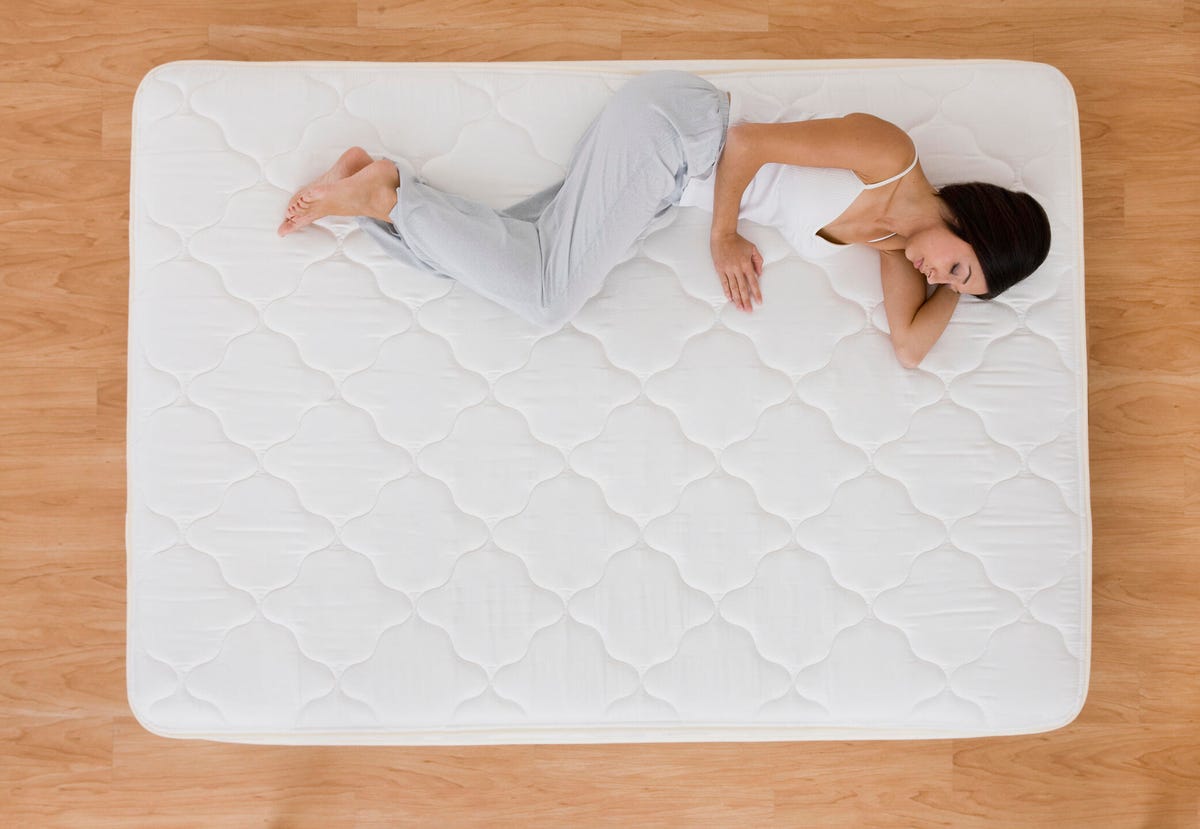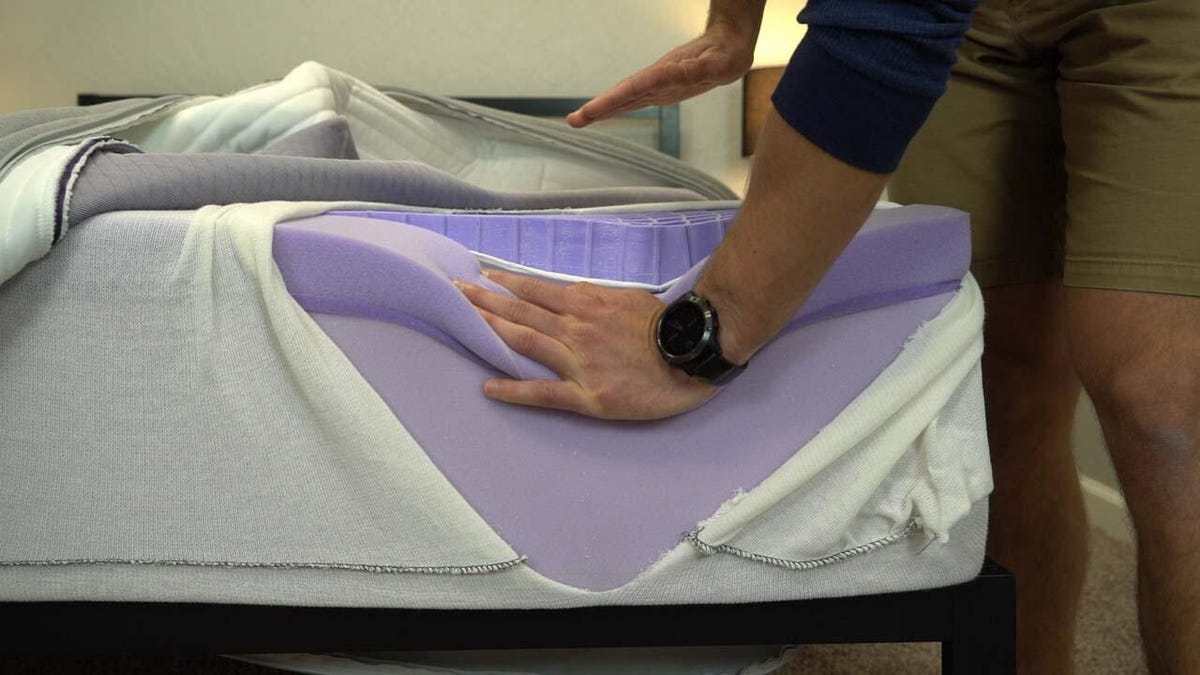If you are looking to upgrade from your old mattress or need a new bed for a guest room, now is a great time to snag premium mattresses at lower prices. Plus, a new bed can revitalize your sleep.
Your old bed may also be contributing to body aches or household allergies, leading you to wake up feeling drowsy or stuffed up. This could be due to pain-promoting sags that naturally form after years of use, a misaligned spine because your bed has softened over time, or possibly millions of dust mites living in the bed flaring up your sniffles. Old beds can actually get pretty gross, let alone uncomfortable.
Whether you’re looking to replace the bed you bought before your 9-year-old was born or you’re buying a new mattress for the first time, you might be wondering how to choose a mattress. There are important considerations to take into account before you make your purchase. Below is CNET’s extensive guide on how to buy a new mattress that’ll suit your needs and promote z’s.

1. Consider your budget
A mattress is an investment in your sleep and you get what you pay for. With that being said, there are literally hundreds of brands to choose from and I think there is a comfy mattress for almost every budget. Here are the general tiers when it comes to bed:
- Budget (around $600 and below): There are several great beds that fall under the $600 mark after discounts. Beds like Allswell or Casper Element should last you several years. You can find the unicorn that offers both comfort and support, but is ultra budget-friendly.
- Average (around $600 to $1,200): You’ll find a majority of quality beds fall within this price category. These beds include Casper, Purple, Leesa and other top-dog brands who seemingly set the standard for pricing on bed-in-a-box mattresses.
- Affordable luxury (around $1,200 to $1,600): Beds in this tier come with extra bells and whistles such as an extra supportive, dual-layer innerspring design or an active cooling cover. These are great values — they could be priced higher, but instead they go for fair prices.
- Luxury (around $1,600 and up): These are the TempurPedic beds and Purple Hybrids of the bedding world. They tend to be very thick, stacked with multiple comfort and support layers, and can include special added features you don’t find with your every-day bed.
2. Identify your primary sleeping position

Think back to last night: Which position did you sleep in the most? That’s important to consider when thinking about how to choose a mattress because your sleeping position can help you determine how soft or firm your new bed should be.
Side
Side sleepers usually feel most comfortable on soft to medium-firm mattresses because they conform to the curvature of your hips and side without pressing into your joints. The less you weigh, the softer you’ll want your mattress to be as a side sleeper.
Read more: Best Mattress for Side Sleepers
Back and stomach
If you sleep on your back or stomach you’ll likely fare best with medium to firm mattresses that offer accommodating support. Firm beds ensure your back and spine remain properly supported all night, as opposed to soft mattresses which can let your back droop into the bed and promote back pain.
Read more: Best Mattress for Stomach Sleepers
Combination
If you think back and realize you sleep in every position, you have a couple of options. Pick the one you think you spend the most time in or opt for a middle-of-the-road option. Medium firmness levels offer enough support for back and stomach sleepers, and they have suitable pressure relief for side sleepers.
A significant number of brands construct their beds with medium firmness levels to accommodate a wider range of sleepers.
3. Take your body type into consideration
Once you’re familiar with your sleeping position, next is to factor in your weight or BMI. Weight distribution plays a part in how soft or firm you think a bed will feel. For example, a medium mattress will feel more soft to Dwayne “The Rock” Johnson, but Olympic gymnast Simone Biles will likely think that same mattress feels a bit firmer than advertised.
Heavier individuals exert more pressure into a mattress, and as a result, have a more plush experience. So, if you weigh 250 pounds and sleep on your stomach, I’d suggest at least a medium-firm mattress.
People with larger body types should also look into hybrid mattresses. These are beds that include both foam and innersprings. Hybrid mattresses are much more supportive than all-foam beds because of their steel base layer. And in turn, that means they end up lasting longer. Though, if you weigh under 200 pounds, most foam beds should work just fine for you in the long-term.
4. Determine the materials you like

The Purple Hybrid comes in three different models, each with a different thickness of the Purple Grid gel layer.
Memory foam isn’t the only mattress material available nowadays. There’s also polyurethane foam which is a lighter, more breathable, quicker-responding material. You also have latex foam, in natural, organic or synthetic form. Natural and organic latex is hypoallergenic and antimicrobial, while all latex foams are breathable, bouncy and spongelike. Latex foam offers more support, durability and airflow than both foams I just mentioned. Though, it can also be more expensive because of its various benefits.
Here are the pros and consof the most commonly used comfort materials:
Types of Foam Mattresses
| Pros | Cons | |
|---|---|---|
| Memory foam |
|
|
| Latex foam |
|
|
| Poly foam |
|
|
5. Do you buy in-store or online?
You’re probably familiar with regular ol’ in-store mattress shopping — the process of laying on beds one by one until you find a good match. But how do you buy a mattress online? It’s just the same as buying anything else online, shipped direct-to-consumer and rolled up inside a cardboard box. Each has their own benefits and setbacks.
If you shop in a store, you get the benefit of hand-testing the beds yourself before you buy. Also, master hagglers might be able to talk a mattress salesperson down on the price of a new bed.
On the other hand, online brands know you’re taking a risk by purchasing a bed over the internet so they sweeten the deal with additional perks such as free shipping, free returns, a lengthy free trial policy and a solid warranty to back your bed. It will be shipped directly to your door, either inside a box or hand-delivered via white glove delivery, taking the hassle out of transportation and additional costs.
Regardless of how you choose to buy your new bed, you should always read mattress reviews. Both from experts and from customers who’ve tried the bed before. They will give you insight on how your prospective new bed will be to your average consumer, and speak the truth on any claims that might just be mattress marketing mumbo jumbo.
Most mattresses will last around seven to 10 years. The exact amount depends on what type of mattress, what it’s made from and how you care for it.
Top signs you need to replace your mattress are:
- You wake up with back or neck pain
- Your bed is sagging or showing signs of damage
- You can feel lumps when lying on it
- Falling asleep is harder than it used to be
There are a ton of mattress options out there, which can make choosing a mattress feel impossible. Here’s the thing about shopping for beds: It’s all subjective. What might work for me might not suit your needs.
The top five things you should remember are your budget, sleeping position, body type, desired materials and whether or not you want to buy online.
Your sleeping position and body type will filter out beds based on firmness and mattress construction. Next, you should decide how you want your bed to feel. Do you prefer a fluffy pillow top or the sinking feeling of memory foam? Asking yourself these questions will narrow down your list of beds significantly.
Mattress material matters when it comes to choosing your next mattress. While there is no single best material, some options will be better for you than others. For example, all-foam mattresses are affordable and mold to your body at night, but they also range in quality and often have lousy edge support. Innerspring mattresses are bouncy and offer a ton of support, but the coils can be noisy and aren’t the best at isolating movement. Hybrid mattresses provide comfort and support, but they are some of the most expensive beds available.





















+ There are no comments
Add yours